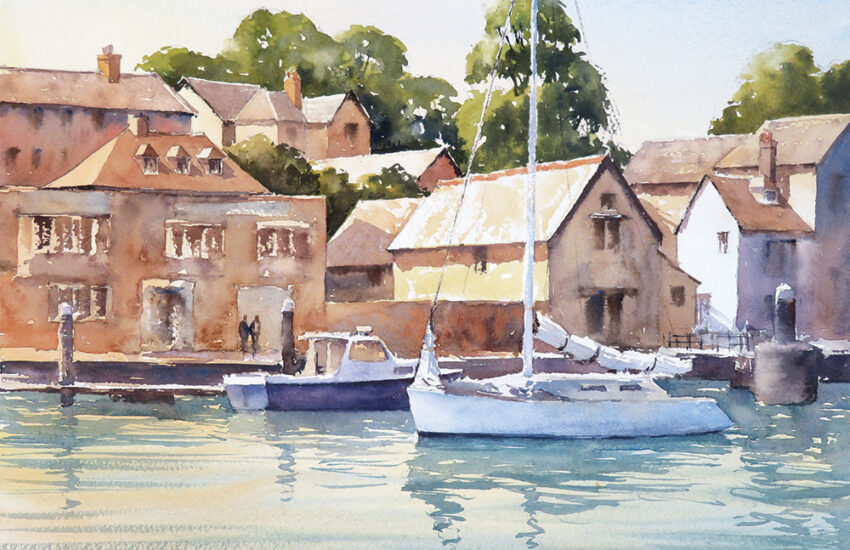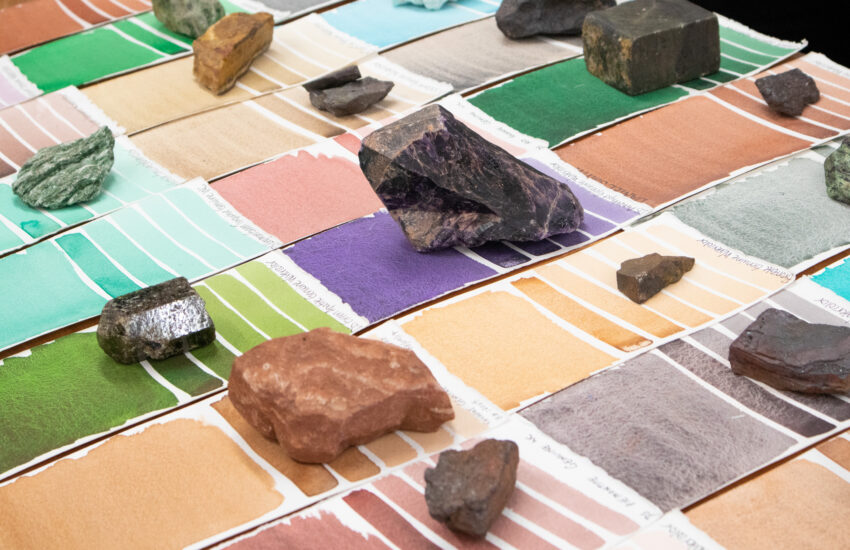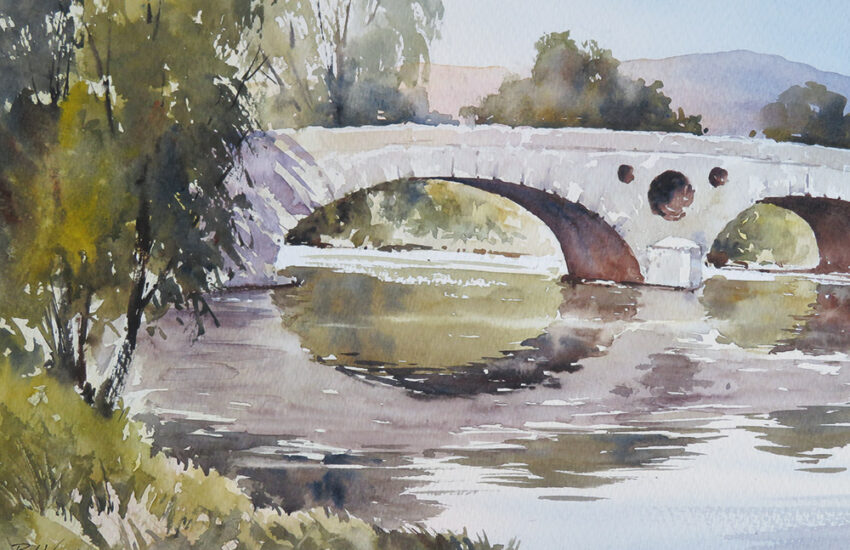Watercolour Paintings Exploring Cultural Themes and Influences in Europe
Setting Out from the Via Domitia
Looking at cultural influences from the past on the life and character of places today.
For over 17 years watercolour artist Nicholas Poullis has been exploring cultural themes and influences seen along the root of ancient Roman roads that lead from Spain through France to Italy. All the paintings featured here are watercolours and were painted between 2003 and 2020.
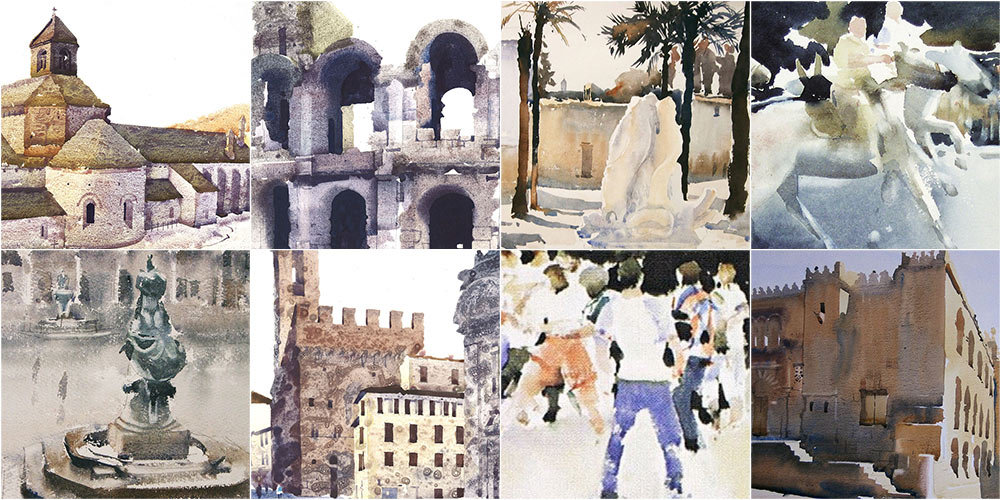
Introduction
From Cadiz there is an ancient Roman route to the northeast, the Via Augusta which changes its name, in France, to the Via Domitia. From Nimes the Via Aurelia leads towards Rome. This route around the Mediterranean passes through regions rich in history and home to many earlier civilisations. The Via Domitia, still visible in places, passes close to my home in southwest France. The character of my area still owes much to the Romans and all the other civilisations which settled there, leaving their traces through architecture, decoration, sculpture and other forms of art. Social traditions also go back a very long way and sometimes the symbols of earlier cultures are reflected in them.
This is a very personal account of my journey along the route of the old Roman roads to create this collection of paintings produced since 2003. It is neither a history nor a travel guide of the area. Where I refer to historical material, events, or anecdotes because it forms part of my concept of the subject I have chosen to paint.
Piazza del Campidoglio, Rome, designed by Michelangelo
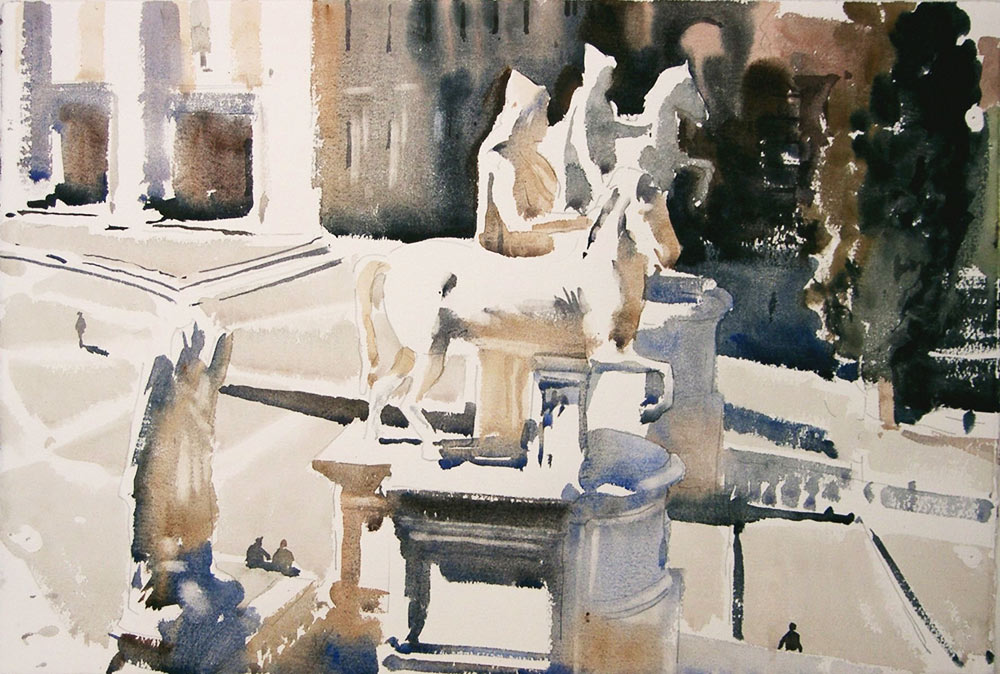
The way in which each civilization strove to express itself through architecture becomes evident when we look at what it constructed and each from of this expression affects our own experiences in a different way. Portraying a building, street, or city square in a painting to convey something of the experience of being there made me more aware of the beliefs and priorities of those who created it in the past. Looking at traditional activities, such as bull running, made me think of symbols of an ancient culture as they appear in its art.
Architecturally, the Romans inherited the Greek world with its temples, theatres, monuments and sculpture. The Greeks developed various types of column and exceptionally fine sculpture. The sculpture is now only seen in museums, but, at one time there was a lot of it around. It provided information and inspiration for the Romans and all who followed them. Architecture was incredibly important to the Romans and clear rules were generally followed. For this reason, a temple in Cadiz may look, identical to one in Rome or anywhere in the Empire. Inspired by the Greeks, the Roman Forum, or square, was also an important feature of Roman town planning, entering it through an arch and colonnade, it was revived during the Renaissance period. Romans used architecture as an expression of their status. Much of it was dedicated to past emperors in the form of temples and triumphal arches. Public and political life was especially important to the Romans and many buildings were dedicated to this.
Orange Theatre Stairs
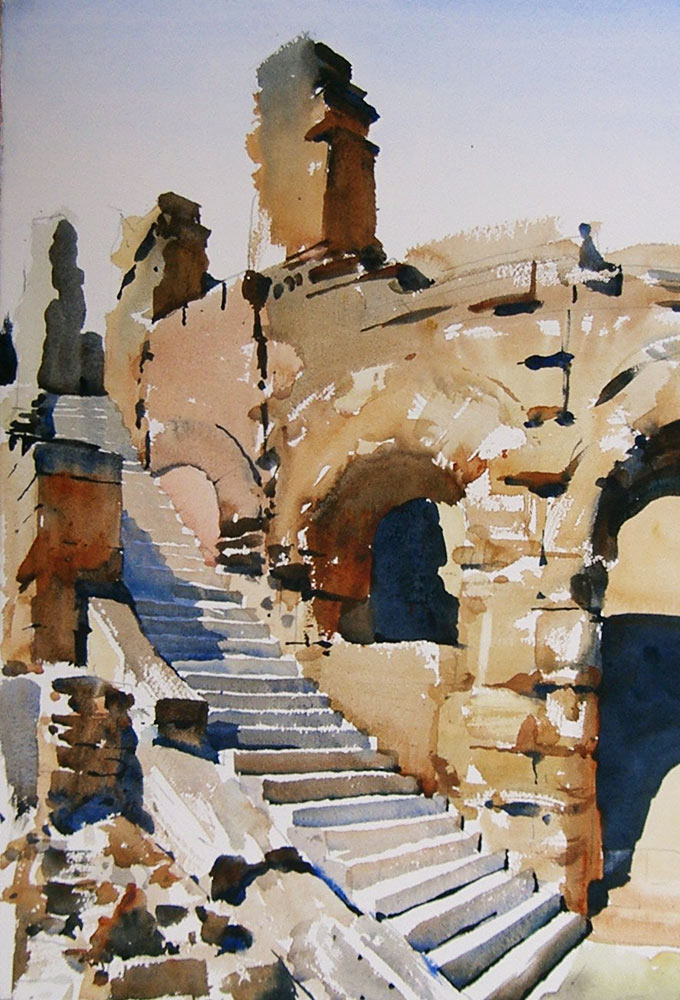
The style particular to a culture and time develops because of and as an expression of prosperity. Both social factors and individuals can affect the course of that development. In Italy, during the Renaissance, Florentine patrons, such as the Medici family, competed. This encouraged the opulence expressed in various art forms. They commissioned artwork on a large scale and, due to the civic role of their patrons, artists were an important part of the social fabric. Given responsibility as architects and town planners, artists enjoyed a greater opportunity to visualise ambitious projects and were encouraged to do so. Thus, they gained more control over the way places came to look and therefore what we see and experience today. These artists saw town planning, architecture, sculpture and fountains as things all working on our senses. By using space cleverly, they affect our experiences of them.
Such was the scale of this creativity that the movement, now known as the Renaissance, not only influenced the art produced and the concept of beauty thereafter but touched every aspect of human endeavour. Places such as Florence and Rome where this happened are seen the world over as of major importance for their art and architecture. So their influence proliferates and becomes not only part of a region’s identity but an influence far greater, as part of our collective history and culture. Every culture uses art as a means of elevating a theme, object, person or ideal.
Cordoba Mosque Exterior & Interior
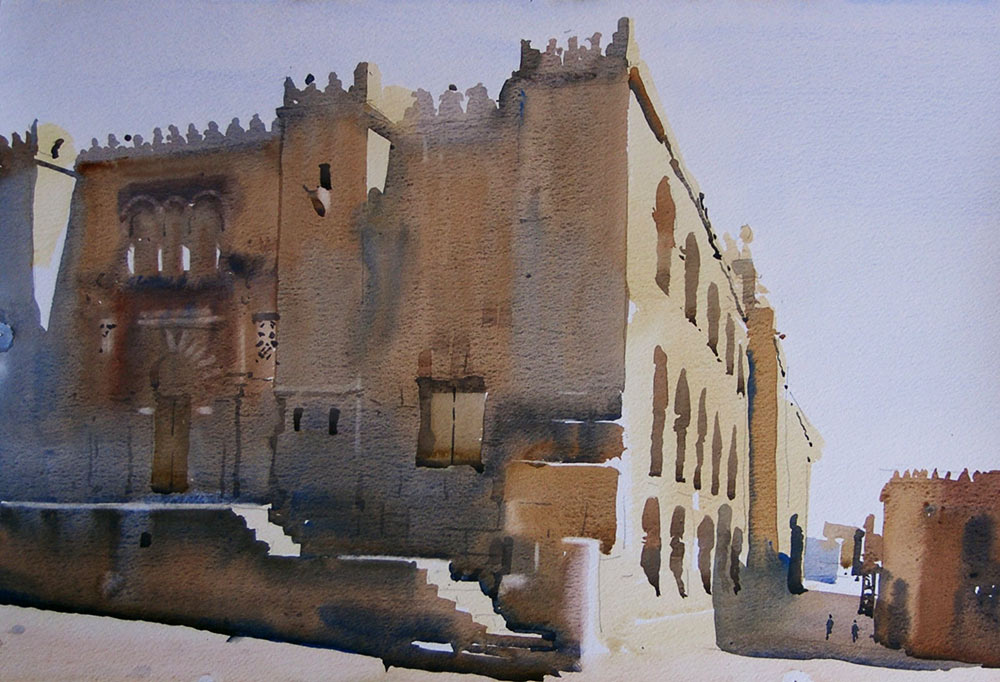
From abut the middle of the seventh century in Spain, palaces and fortresses were built by an Islamic civilisation. Islam united Arabs and gave them the energy to invade what was, by that time, Visigoth Spain. Islam forbade all representations of the human form and this led to an art dominated by abstract non-figurative decoration. A derivative of this can now be seen as decoration on buildings in the form of tiles and patterns painted on walls. Motifs used in décor can also derive from the important features of local life and tradition. The bull’s head often appears in both southern Spain and in the Camargue region of France. Variations in influence can be very subtle; for example, the shape of the Moorish arch is different to that of the Roman. (The arch popular in Moorish architecture is, in fact, derived from the Roman.)
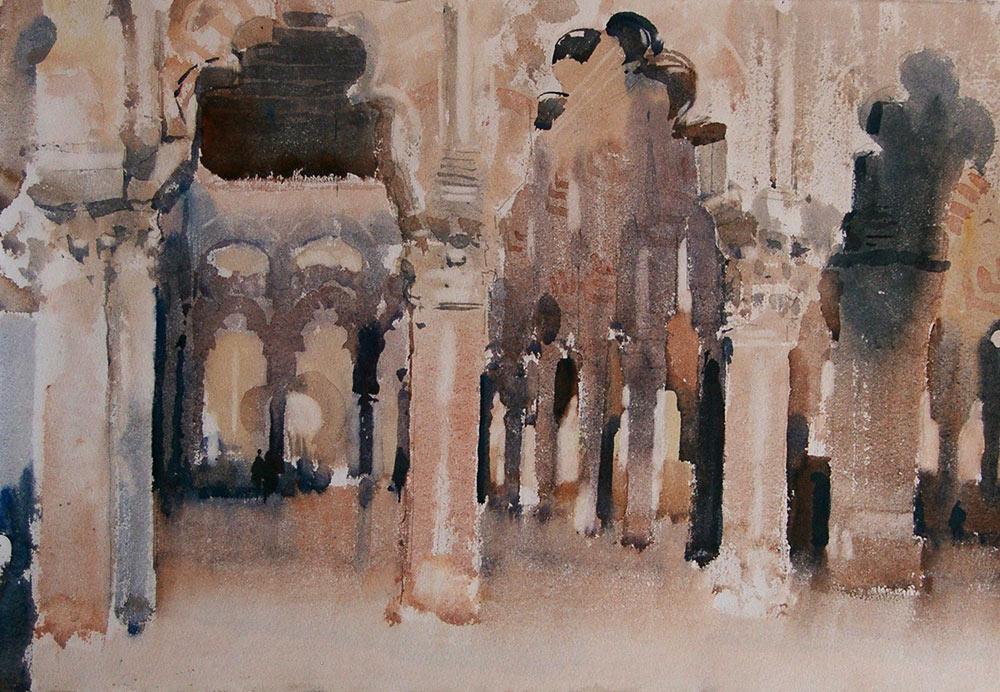
St Guilhem le Desert
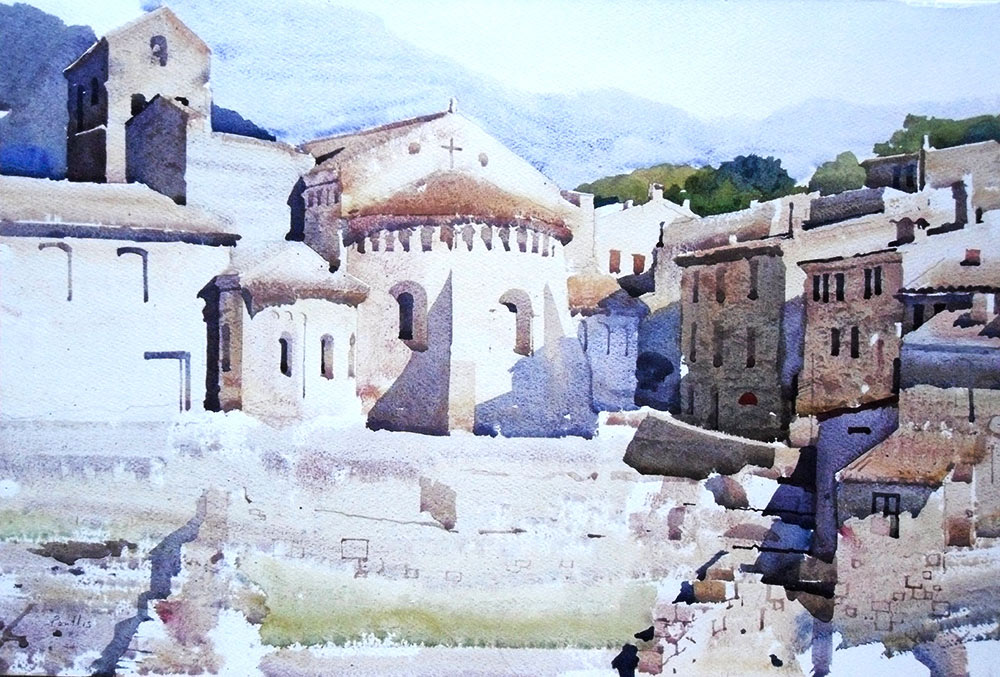
Cadiz
Cadiz, where my journey begins, is the oldest city in Western Europe. At about 1250- 1200BC the Phoenicians, a nation of sailors and traders from the Eastern Mediterranean, were becoming more powerful and established ports for trade along the coast of Spain, France, Italy, and further East. In Cadiz, bronze was traded for textiles and spices from the Orient. From here the Phoenicians also traded for tin from Britain and Brittany. Through trade there would have been contact with cultures to the east and the north. Although founded approximately 3000 years ago, there was of course, people there already. By about 3500BC there is evidence of metal working in the region. From about 2500- 1500BC south Iberia was a centre of early bronze working. Near Cadiz on the Via Augusta, is the Roman port of Baleo Claudia, now in ruins. In Cadiz itself is a Roman theatre, now the home of the local stray cats. Cadiz was used as a trade port with America after the de monopoly of Seville. The wealth generated led to the building of the cathedral. Today it is an active port both naval and commercial.
Cadiz view from Torre Tavira
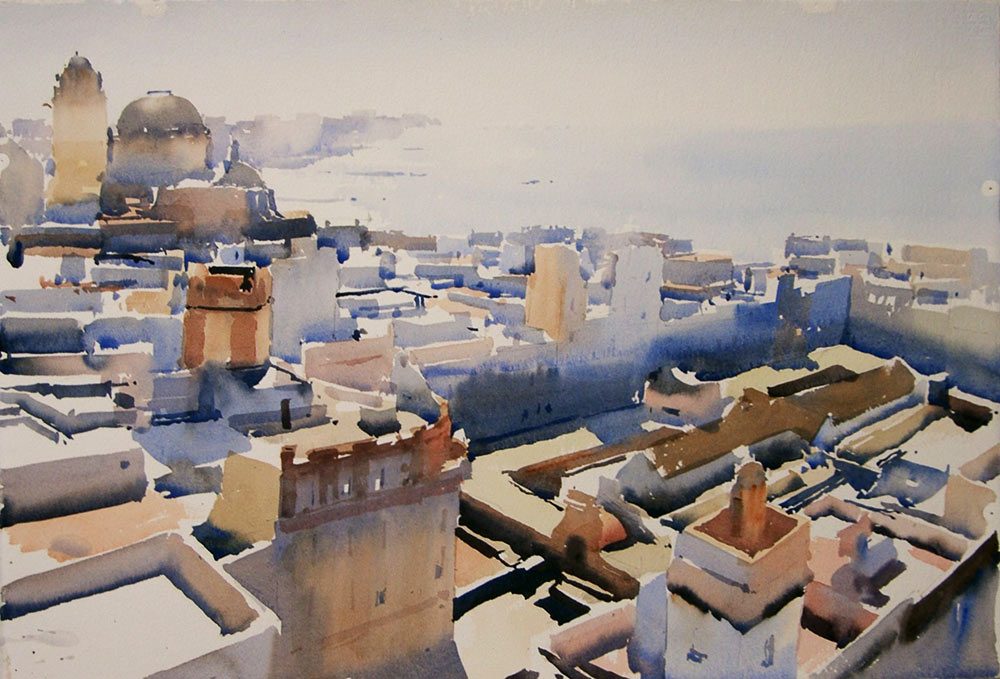
Cadiz is a long way from where I live in the Languedoc. Travelling the motorways that run along the ancient route, the landscape and climate change. South of Barcelona it gets hotter and road travels through orange groves and their smell fills the air. On cliff tops there are often castles. Cadiz is constructed on a peninsula and the oldest city in western Europe has the feel of somewhere exotic, like Morocco or Algeria. There used to be over 150 watchtowers here so that ships using the port could be spotted and taxed. Few of these towers remain, the tallest is the Torre Tavira, from which I painted views of the city. The streets are narrow and to an extent run parallel in pairs. This is characteristic of Phoenician town planning although these are medieval or later – with some still being built. The buildings of northern Africa design are flat rooved and terraced. The houses are often tall and built around a central square courtyard filled with plants to help keep the building cool. Tiles form a large part of the décor and have an Arabic feel to the design. Much of Cadiz is built of oyster stone brought up from the seabed, it is like natural breeze block in that it is light for its volume.
Back street of Cadiz
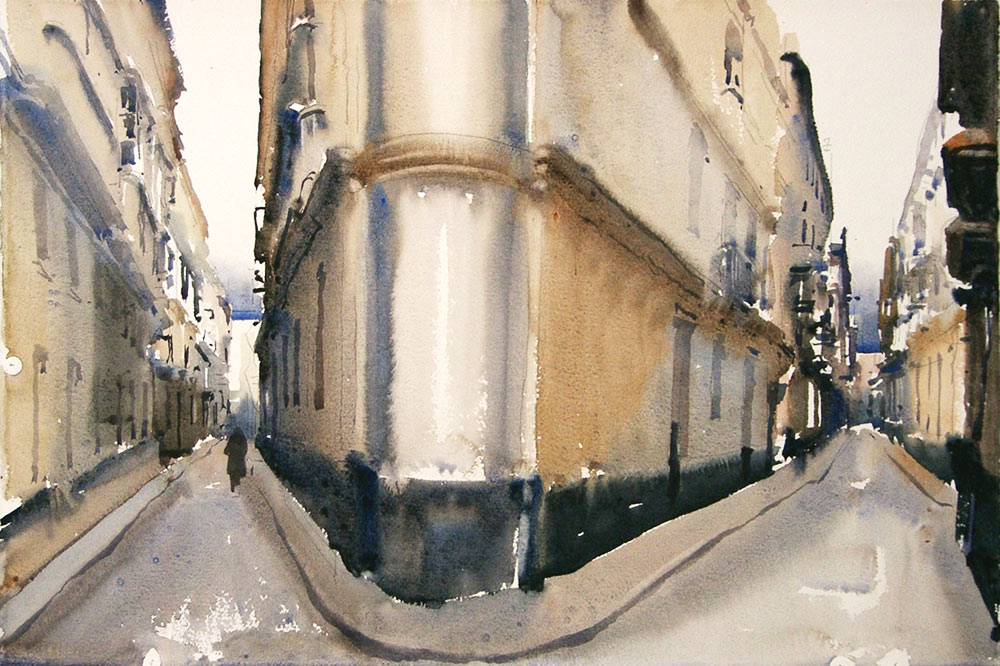
Jerez de la Frontera
Jerez de la Frontera Broken fountain
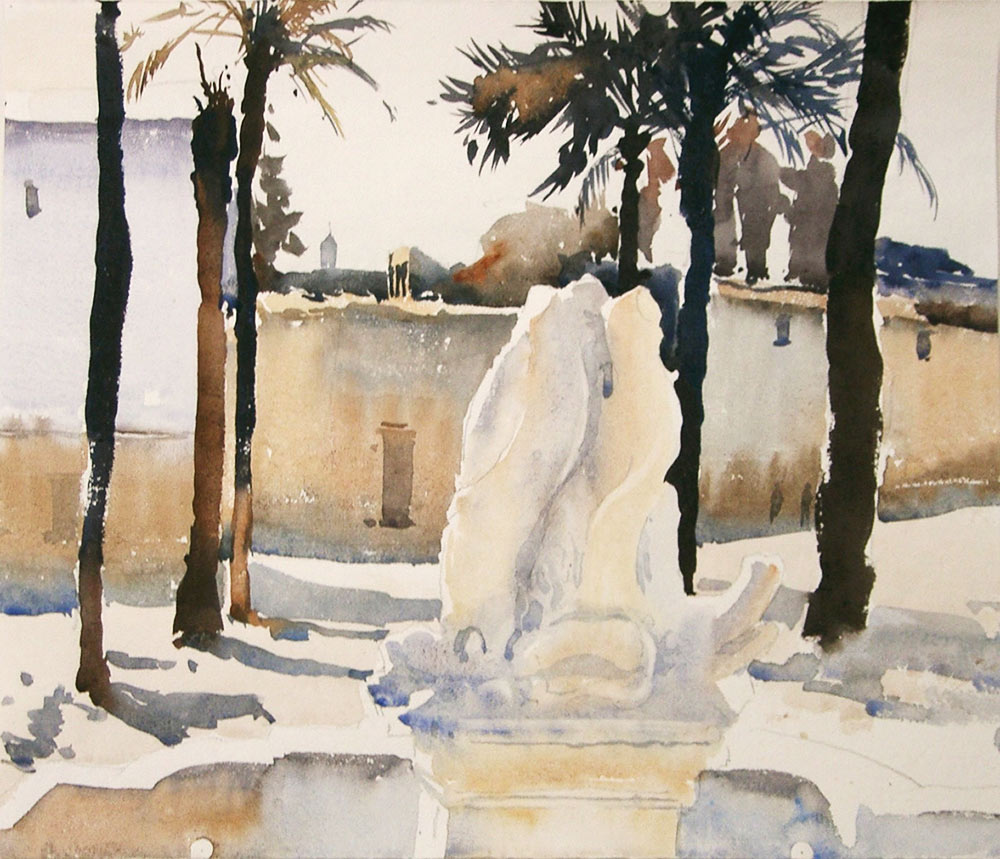
Jerez de la Frontera is famous for its sherry. Horses and bulls are bred here in the Camargue. Forming part of the palace complex are some ancient Islamic baths. Baths had an especially important place in the social life of the Romans. As the western part of the empire faded, their design and building methods passed, along with many other elements of Roman culture, towards the east to Byzantium. From here, the design and practice of bath building passed through the Islamic culture to Spain. Each bath has three adjoining rooms. In arched ceilings, pointed stars are cut to allow steam out and air and light to enter. The same stars can be seen in the decoration of both tiles and doors. Some of these decorative tiles are seen on the roof of local churches. Carved bullheads which decorate a church here can also be seen on churches near the Camargue. In Jerez, I found a sculptured fountain which was no longer working and had been damaged, according to locals, by children throwing stones at it. The sculpture, of grotesque fish sloping, down with water pouring from their mouths, was a motif I also found in Nizas, southern France, and in Rome in front of the Pantheon. It is a 17th century design and, like the bull head, is a popular motif drawn from local activities.
Xàtiva
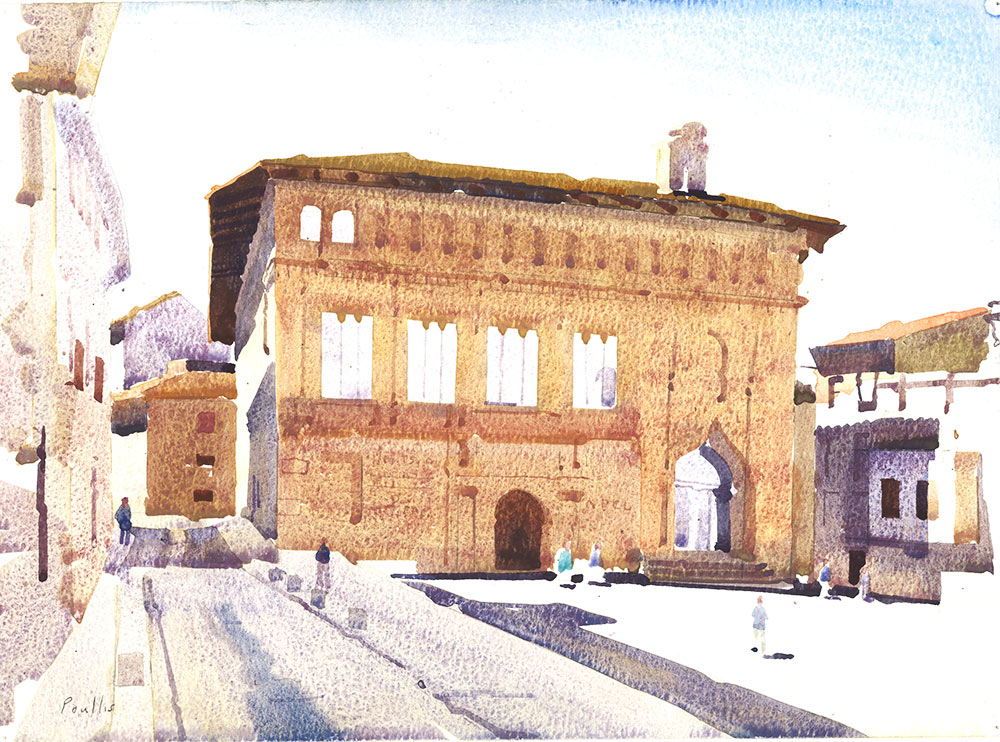
Provence
Nimes Temple de Dianna
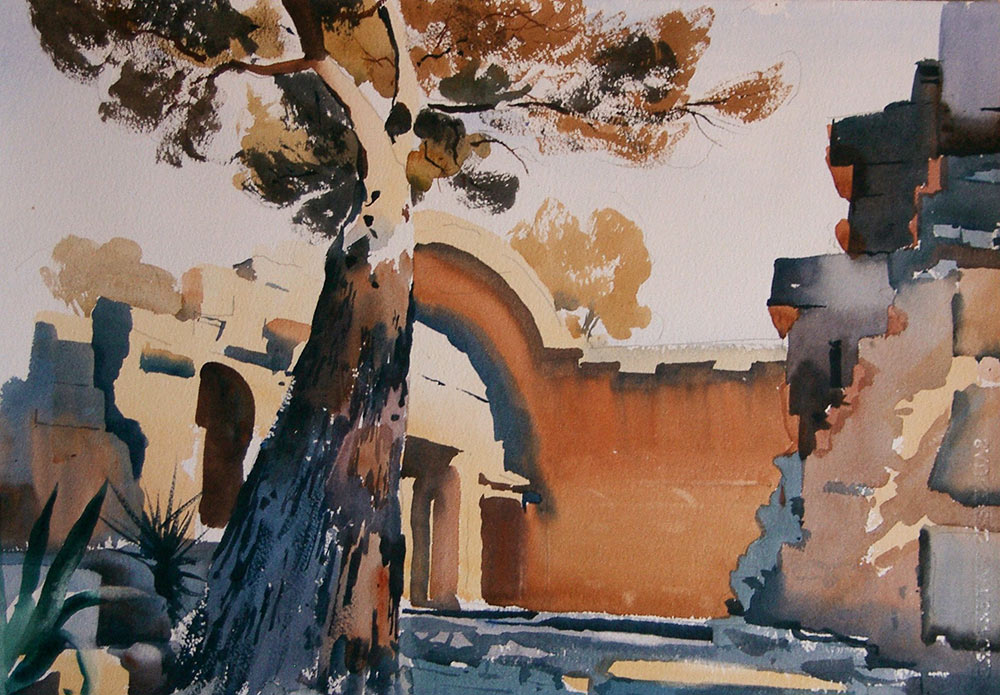
One area the network of Roman roads passes through is Provence. The Via Aurelia and the Via Domitia meet at Nimes. The Phoenicians had founded Marseille by the 5th century BC. Between the 4th and 3rd centuries BC, the Phoenicians of Marseille, known as the Massiliote, moved north, and founded places such as Gallum, Nice, Villefranche and Antibes. During this period, the Celts invaded the Liguan held backcountry and the two cultures mixed. Due to the influence of the Greeks, olive trees and vineyards were planted, changing the countryside, and defining the region thereafter. During the second and first centuries BC, Marseille came under increasing threat from raiding tribes and so asked Rome for protection. Rome responded by sending garrisons of troops which installed themselves as part of the expanding empire. Aix-en – Provence became their provincial capital. Over the next few centuries, this region saw some of their most impressive and ambitious buildings, such as the Pont du Gard. This aqueduct and bridge spanning the river Gard, brought water to Nimes. By the 6th century, due to increasing pressure the Roman Empire had ended here with the invasion of Visigoths, Ostrogoths, Saxons and Lombards.
L’Abbaye Notre-Dame de Sénanque
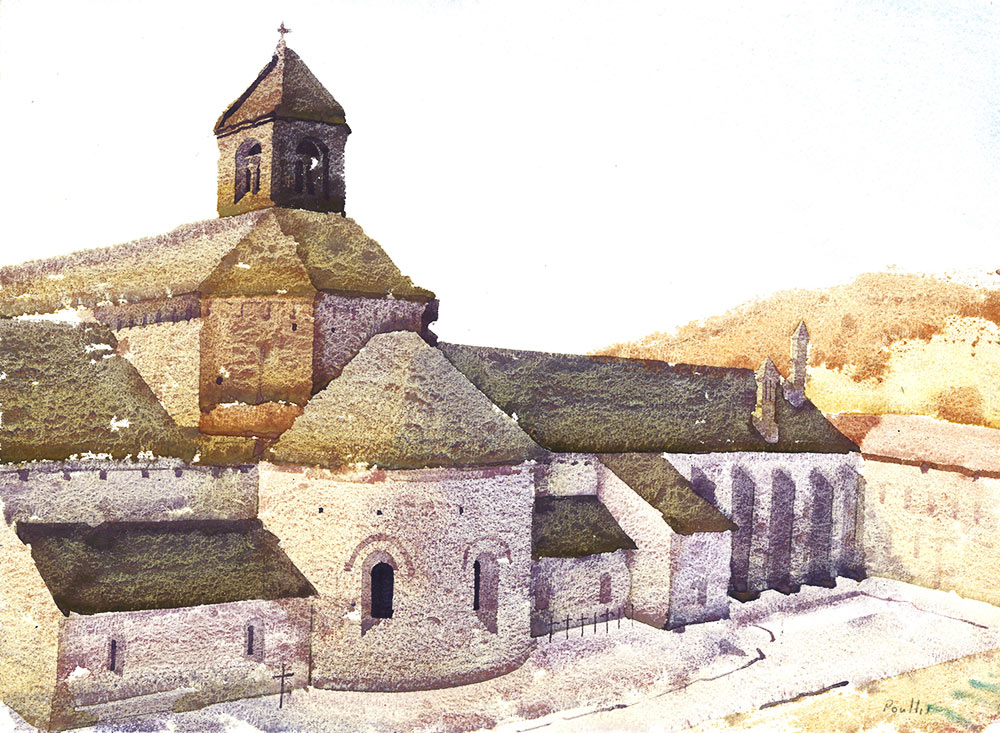
Arenas built during the reign of Hadrian 117-138 AD, under whom the Pantheon had been rebuild and redesigned, can be found in Nimes and Arles. The Arena in Arles is one of the oldest to survive. It has been used as a fortress and later as a refuge for the homeless and as a source of building material. The top tier has gone but two chapels were added, the ancient surface has become scared and pocked. The 19th century restoration is obvious, but because of it we can appreciate some of the architectural detail lost to erosion. About 13BC a coast road was built into Gaul and became known as the Via Aurelia. The roads made it easier to move the military about, but they were also commercially and socially important. The Via Aurelia passed through Glanum at St Remy de Provence. At St Remy, Van Gogh spent time painting, visiting brothels and in hospital. It is impossible to walk about here and not see what inspired Van Gogh. The simple images he painted gained inspiration from what defines this countryside. His paintings of olive trees with a backdrop of the Alpilles, the last chain of the Alps, refer to some of the regions identifying features. Due to his art and its recognition in our time, the subjects of his painting have themselves gained in significance.
Every business around seems to ne be named either after him or Nostradamus who was born here. Nearby is the site of Glanum, uncovered in the 1920’s and therefore unknown to Van Gogh. It was founded by Phoenician merchants in the 6th century BC around a spring, they built temples and baths and it was a port of call for those traveling between Avignon and Marseille. Romans occupied Provence by about 102BC and Glanum came under its control. At the entrance of the city are ‘the Antiques’, the oldest arch in Narbonian Gaul, and a cenotaph from 1st century AD decorated with mythological scenes carved in relief.
Arles
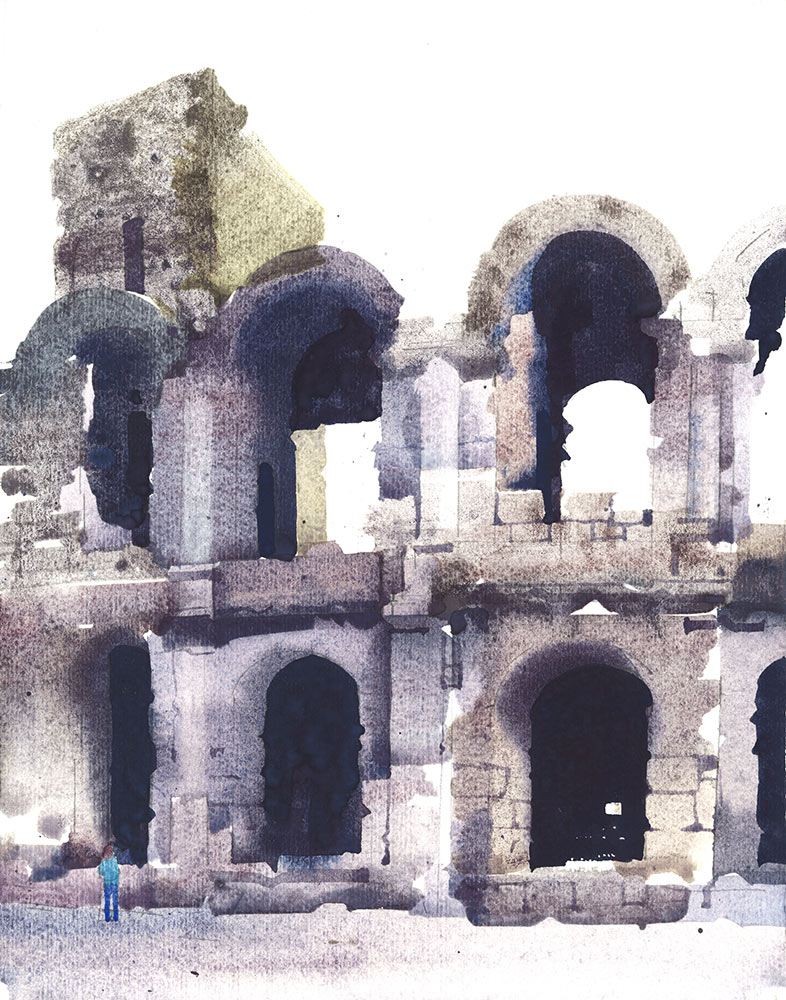
Les Baux de Provence
The church of St Vincent Les Baux de Provence
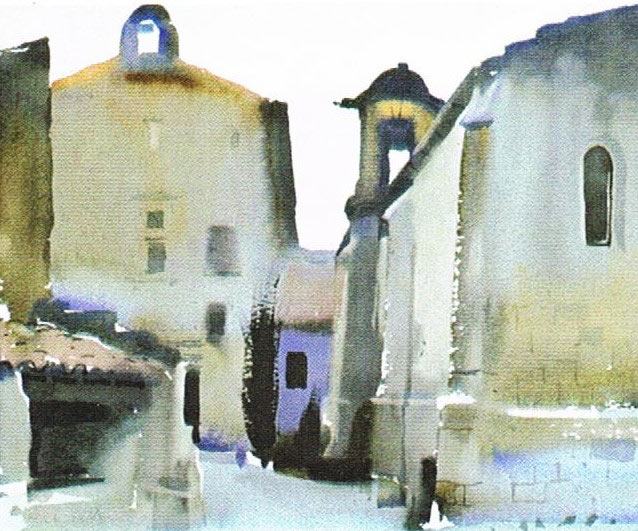
Now largely in ruins, Les Baux de Provence was once powerful and in the tenth century was the home of a feudal family which controlled seventy-nine towns and villages. By the end of the fourteenth century it was the seat of a civilised court at the centre of troubadour poetry, important in the development of a concept of love and ideas of romance. The lords of Les Baux claimed to have descended from Balthazar and remained powerful for centuries. Following the death of the last princess, power passed to the courts of Provence which later became part of the kingdom of France. In 1632, Louis XIII decided to have the castle and walls destroyed to subdue the local power base and to deter the growth of Protestantism there. The church of St Vincent has a 16th century tower topped with a dome. On the death of an important citizen a flame would be lit there. To the left of the church is the 16th century Maison des Porcelets.
Jean de Brions house, Les Baux de Provence
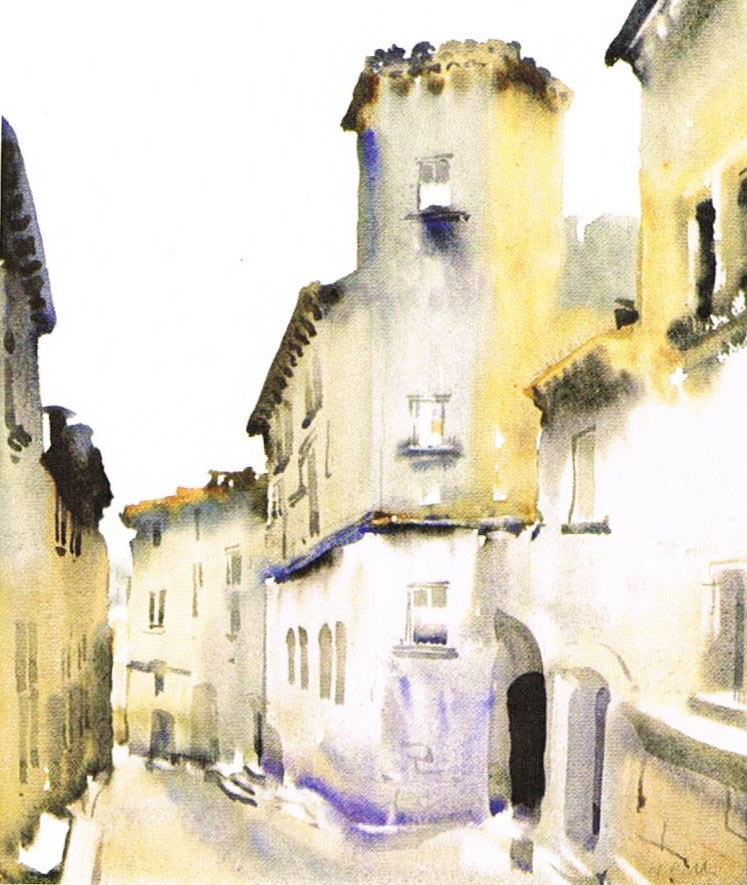
Beaucaire, Abrivado, July 2004
My visit to the Abrivado, at Beaucaire in July of 2004 served as a vivid reminder of the value placed on bravery in the gladiatorial sports of ancient Rome. Protective barriers and a growing tension among the spectators gathering behind them suggested that what was about to unfold could prove to be a challenge to paint.
How do I find the best position to see the event without the risk of being skewered by a bull?
I need to be in front of the barriers to see well enough, but will I be able to retreat through the barrier bars in an emergency?
With a huge bang, a gun announces the start. A bull released a hundred metres away, hurtles down the track and big men with large wooden boards help to funnel it to the point of capture where eight or more people jump on it; two grab the tail and two get to work on its head. The bull has different ideas and throws them into the air and charges off. As the bulls are released even the bravest of Pastis drinkers look scared.
Abrivado
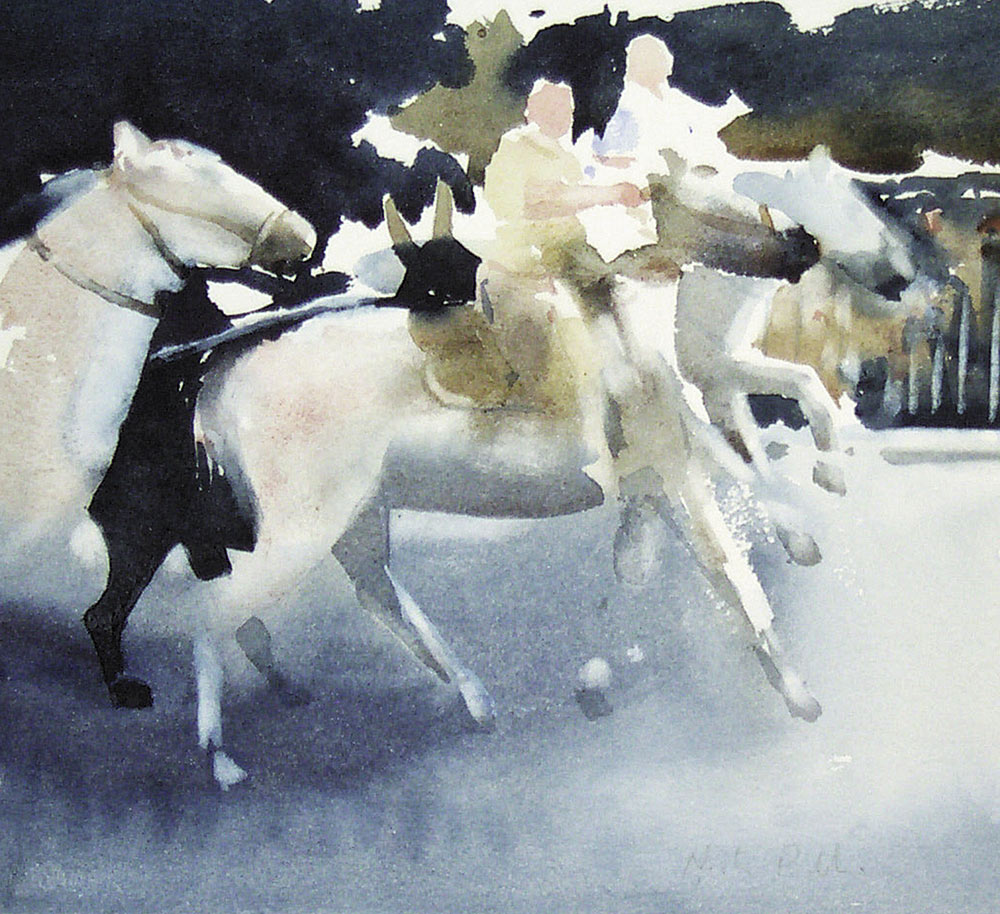
One bull lurches towards the crowd. Spectators swiftly slide to safety between the bars, knocking women and children out of the way. The bulls are released sometimes one by one and sometimes in groups of around ten. A smallish bull picks up its head and lifts a large man fuelled with Pastis; the bull then hurtles off dragging another man with its tail.
In this family event, children get involved by teasing the bulls and slapping them as they run past. Now and again guardians on horseback gallop the bulls into position. All this is merely a preliminary to the main event, the release of one hundred bulls.
The atmosphere changes as even the big guys are getting out of the way. Some cannot fit through the gaps in the barriers and so run for it, others just drink more Pastis. There is a noise and a cloud of dust as the guardians on horseback move out of the way. There is a rumbling from a distance and then the stampede arrives. One hundred bulls at a gallop make the ground shake as they pass a couple of metres in front of me. Then quickly, it is all over. The bulls have reached the arena where they will stay for the next week or so before arriving on a local menu.
Abrivado 2
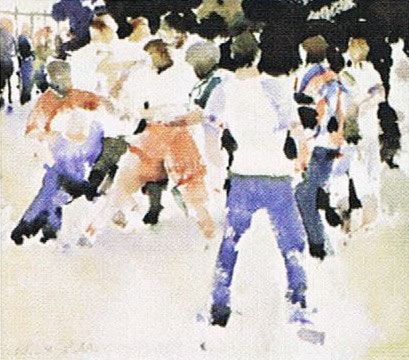
Rome
Rome Street of Corso Vittorio Emanuele
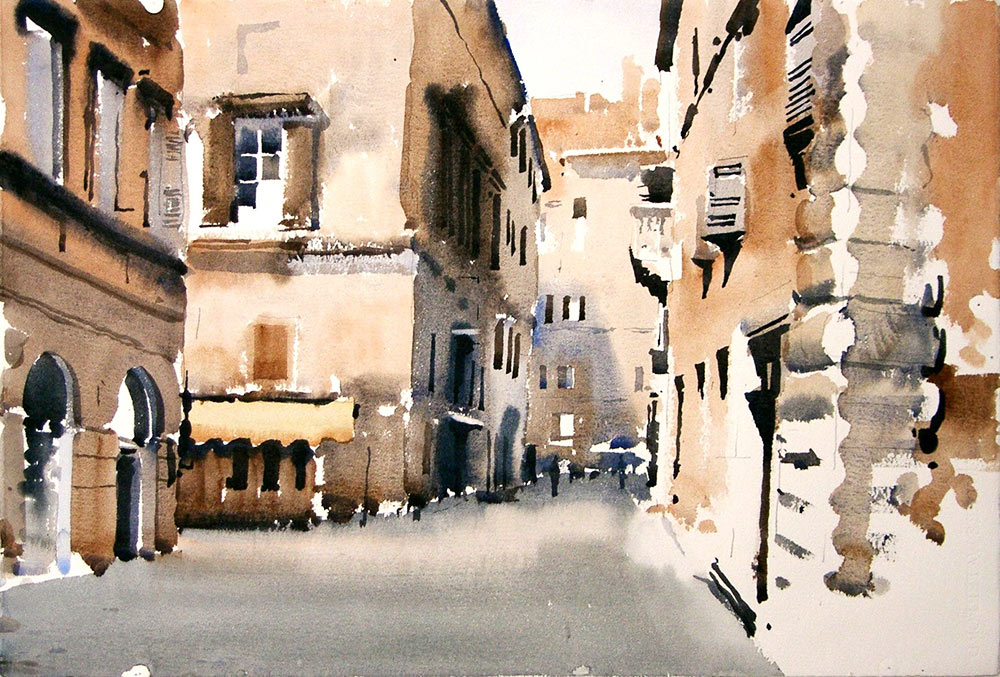
In Roman architecture there is often a resonance of the Greek. The Etruscans, Rome’s neighbours to the north, taught settlers along the banks of the Tiber how to work with metal. Etruscan Kings ruled Rome for about one hundred and fifty years from the mid-7th century BC. The Etruscans were very much influenced by contemporary Greece as is evident in surviving temples. In around 510BC the last monarch was overthrown and a Roman city state, a republic, was created. Romans then established colonies in central Italy. There was a Gallic invasion in the early 4th century BC and the Servian wall was built to protect the city. In around 312BC the first aqueduct was built as well as the Via Appia leading south. Territory trade and influence grew by way of various wars. With the sacking of Corinth in 146BC the Romans controlled Greece. Refugee Greek architects designed temples for the Romans. Greek works of art, particularly sculpture, entered the Roman world and influenced its artists. Recognising the powerful effect of architecture, sculpture, carving and decoration on people, art was used by the Romans to further political ends and, more generally, as an expression of the way they saw themselves.
Piazza Navona
Piazza Navona fountain of the 4 Rivers
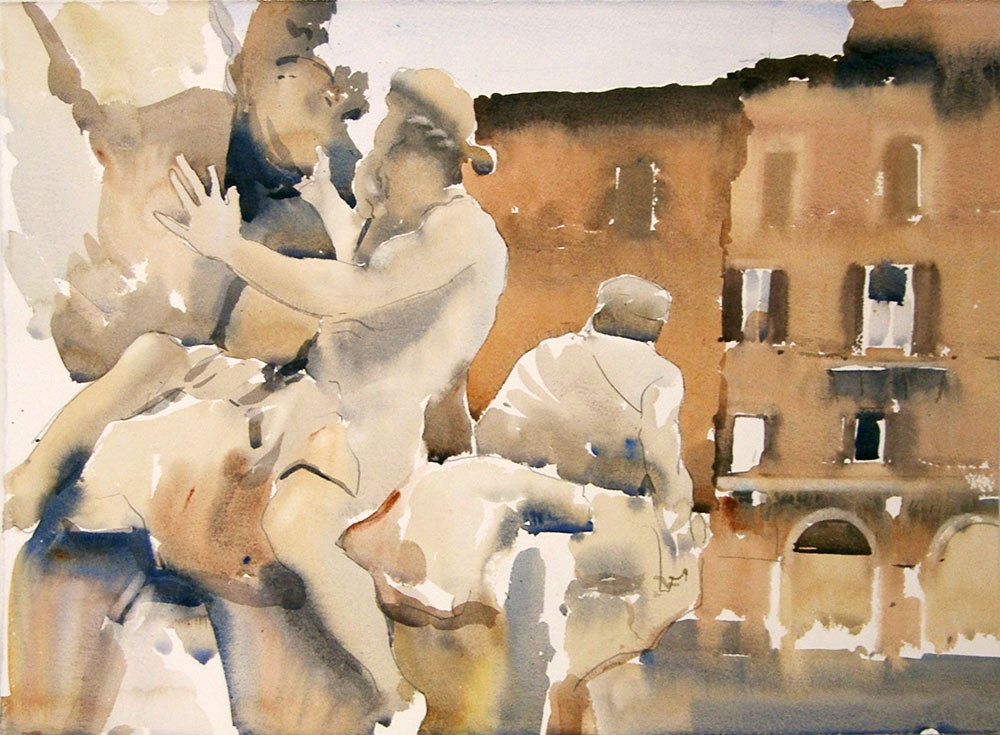
This is in an affluent part of Roma and Burlesconi had apartments above the square. In the 17th century the palace of Pope Innocent X commissioned artists to create the noblest square possible and in 1652, work began on it. In 1647 Borromini had plans to place an Egyptian obelisk on a fountain he had designed but the project was passed to Bernini 1598-1680 who created ‘The Fountain of the Four Rivers’. The piazza kept its roman ground plan of the Stadium Domitian 81-96AD; At the end of the Piazza is the original entrance to the stadium, an arch on the lower street level of antiquity. In the centre of the piazza, Bernini’s fountain represents the Nile, Ganges, Danube, and the Rio de la Plata. Constructed 1648 and 1651, it supports an obelisk moved from the Circus of Maxentius. The dove on the top is a symbol of peace. The figure of the Nile is depicted with its head covered, believed to represent the fact that at the time the source was unknown to Europeans. Bernini’s rival, Borromini, had contributed to creating the church of Saint Agnese in Agone, begun in 1652, and sited next to the fountain. Another theory is that Bernini covered the head of the Nile to prevent him from looking at his rivals’ work. In return, Borromini played the same game by placing a figure with its head turned arrogantly away from the fountain, perhaps as an expression of annoyance that Bernini had been commissioned of the work rather than him. Their creations do seem to fight for attention and dominance in the square.
Piazza Navona fountain of the 4 Rivers 2
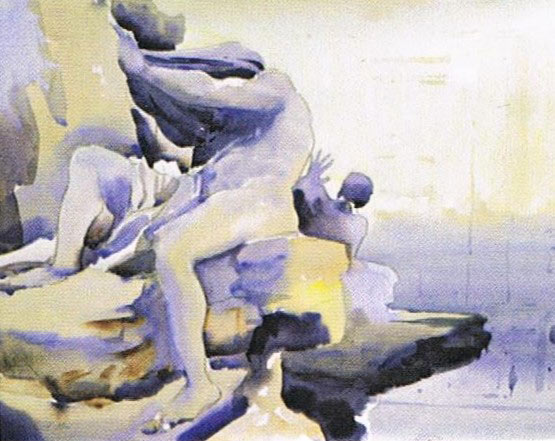
The Pantheon
Pantheon and Fountain
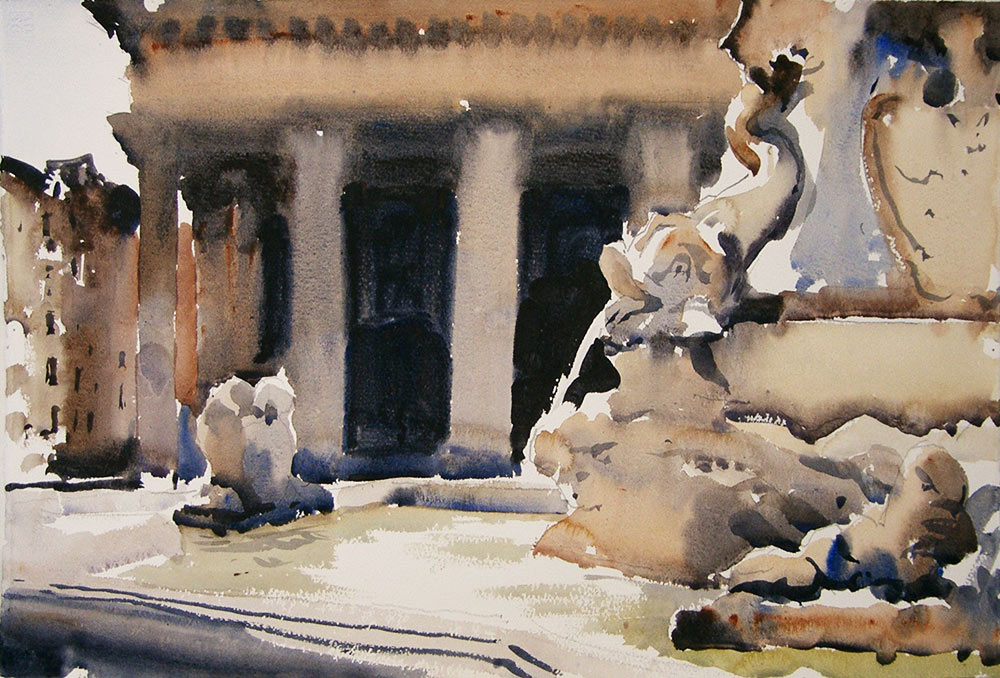
The Pantheon, reconstructed between 118-128 AD by Emperor Hadrian, was consecrated to protect it from being quarried. This massive, old building, set two metres below modern street level, has a portico of sixteen huge columns. Apart from the brick and concrete structure, much of the antique decoration of the exterior, due to erosion, has the appearance of partly melted ice cream. The Romans are well known for their use of concrete, but they never left it exposed – it is not a beautiful material. It was always faced or covered completely with by marble or brick, for example. On its exterior can be seen relieving arches in brick which are hidden on the inside. The Egyptian granite of the huge Corinthian columns and some of their capitals are in near perfect condition. The original bronze doors are still in place and are in use. By putting my finger through holes in them I find these huge doors have an irregular outer skin of between half and two cm. I walk in and immediately enter a large circular room over forty metres in diameter. Strangely I can no longer hear the noise from the surrounding city – and Rome is noisy! At the top of what appears to be the inside of a dome, a concrete cap, is an oculus of about 9 metres in diameter. At 43 meters above it looks smaller and the effect is sublime. It allows weather into the room and in the center of the floor is a wet patch. The Pantheon was designed from the inside out, unlike the classic Greek temple for which the outside was of ultimate importance. On the outside of the Pantheon only the Entrance and the portico is of any importance and it looks like one end of a Greek temple. The inside is largely unaltered from Roman times. Decorated with coloured marble it used to house sculptures of Roman gods. Romans believe that the gods themselves inhabited the sculptures. I wonder if this belief helped to reinforce their belief that sculpture had such a powerful influence on people. As the sun shines through the oculus it skirts around the walls and past the tomb of Raphael with its epigraph, ‘here lies Raphael. Living, great nature feared he might outlive her works and dying, fears she herself may die’. It is a clear indication of the status of the artist, during the Renaissance, that not only the masters tomb is here but also that of his most important assistant. At some point of the year the shaft of light shines directly down, and I could imagine an emperor, believed to be a god, standing directly beneath it. Today it is likely to be a tourist.
Florence
Florence Pazzi Statue
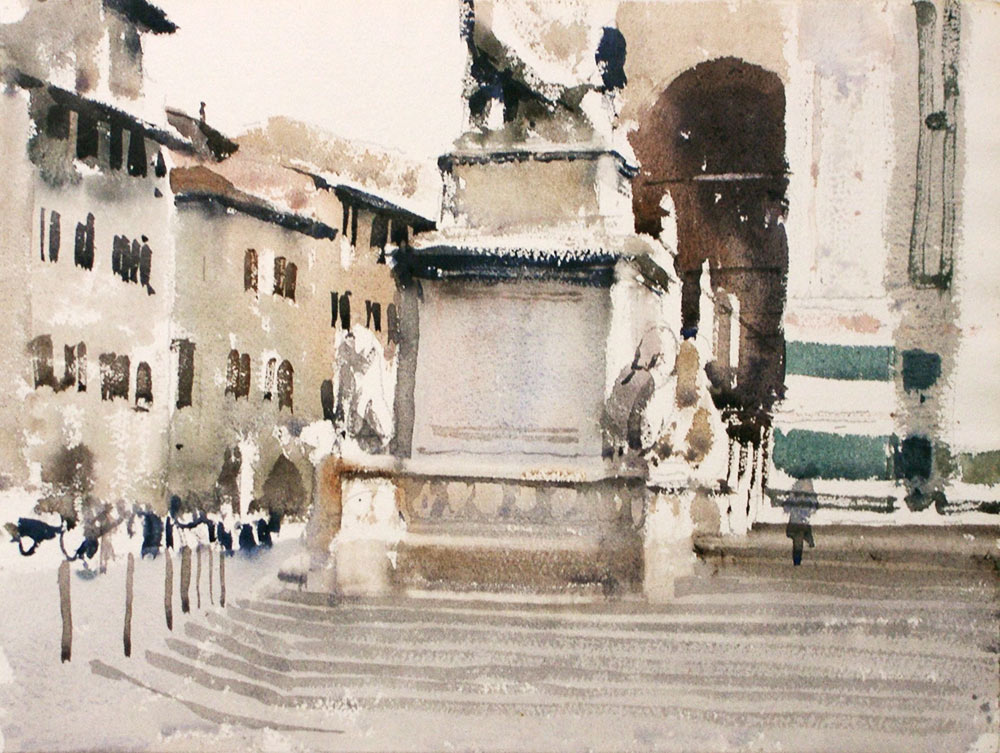
Situated I the Arno valley, Florence has Etruscan origins. It was founded by Caesar’s veterans of the Sulla war and given the name ‘Florentia’ in the first century BC. As the Roman empire fell into decline, Florence was left vulnerable to various barbarian invasions from the North. Feudal lords also adversely affected the city and in 1115AD the Florentines formed a free commune which gradually grew into a city state. The Medici family grew in influence and in 1397 founded their bank and consolidated their position. By about the middle of the fifteenth century there was a great deal of competition for wealth and power between the cities of northern Italy. Wealthy families became the dominant patrons of the arts. An indication of the significance of this development is the life size bronze of ‘David’, by Donnatello, commissioned by the Medicis. It was the first life-size sculpture since Roman times. Merchants built palaces and their property came to influence the look and importance of places. Town planning became more important and was expressed in artistic developments such as the concept of perspective. Rich trade guilds took a civic role and commissioned various buildings. What can be seen today dates from late 12th century onwards. A number of individuals were enormously creative during this period and greatly influenced the artists that followed them. At about this time the role of the artist changed, and they were given a great deal more responsibility. Giotto 1266-1337, who built the bell tower next to the cathedral, is a great presence here. More beautiful to me is the 11th century octagonal baptistry, believed to have Roman origins. To the right of my painting painted from in front of the cathedral, the 11th century building shows greater restraint than its neighbours and its marble decoration is also better proportioned. I found the intense ornate nature of the cathedral and its geometric design like strobe lighting on the senses. This is the religious centre of Florence and the form of the décor typically Florentine. Partly seen on the right of my painting of the Pazzi statue, the church of Santa Cross houses the tomb of Michelangelo. The façade of the 1294 church is in fact 19th century. The painting features the base of the statue dedicated to Dante Alighieri by Enrico Pazzi 1865 and was moved here from the centre of the square in 1968.
In front of the Cathedral Florence
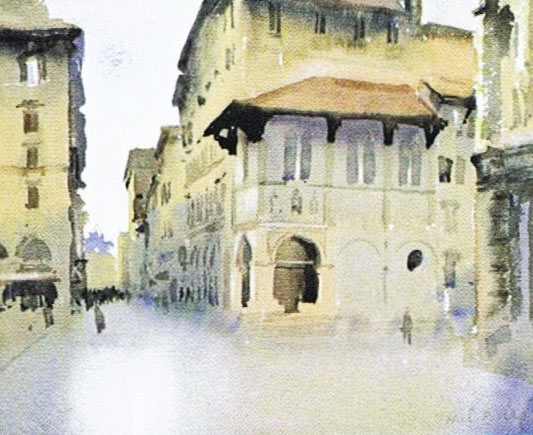
The Foundling Hospital, Piazza Annunziata
Florence Piazza Annunziata
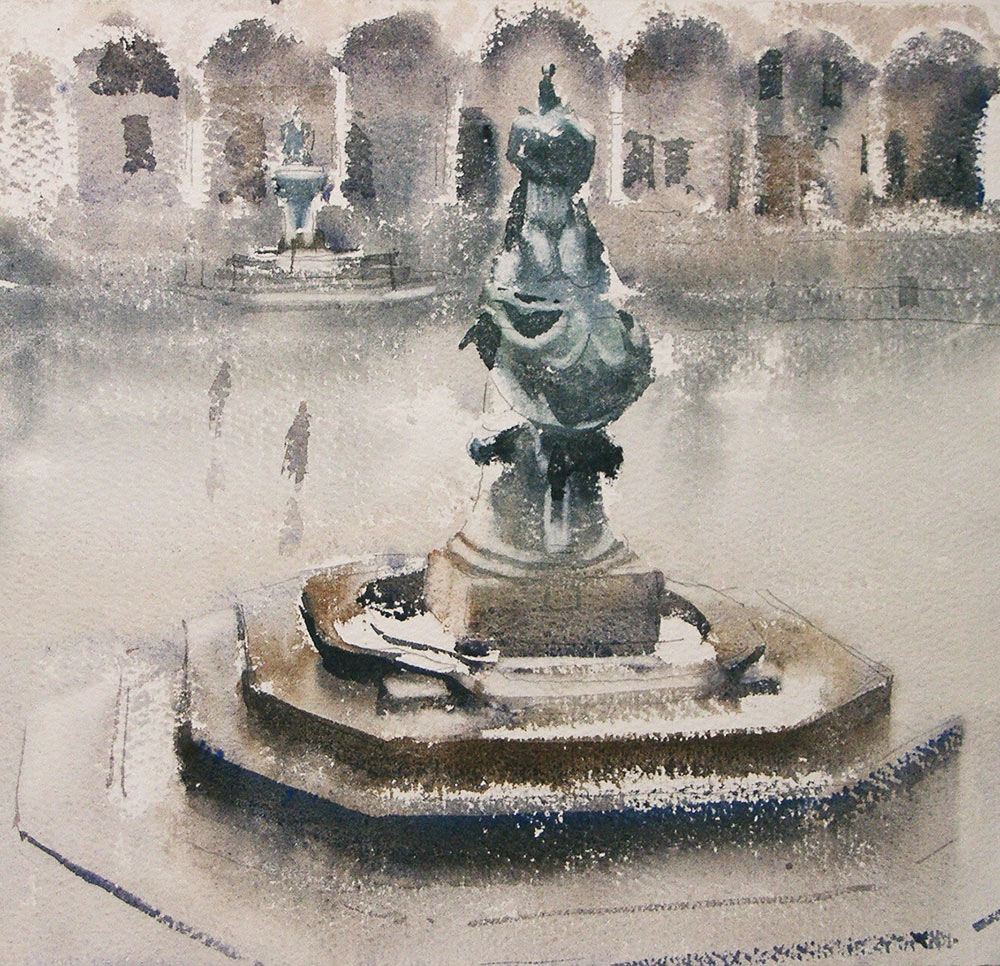
The famous dome of the cathedral was by Brunelleschi. The dome is huge and announces the importance of Florence, not only to the region but to Europe as a whole. It is both a celebration of artistic achievement and a symbol of political and commercial strength. Brunelleschi also built the foundling hospital, considered the first renaissance building, and forming Piazza Annunziata. The hospital was begun in 1420 during the Florentine republic. Brunelleschi had studied the architecture of ancient Rome, giving rise to the town square that could be entered through an arch inspired by the Roman forum. The feel of the building is different to its Roman ancestor. It is lighter, less imposing and on a smaller, more human, scale with finer columns. Drawing on ancient Roman building methods and ideals, Brunelleschi promoted the importance of town planning and the role that buildings could play for the people of his time.
Florence by the Bargello
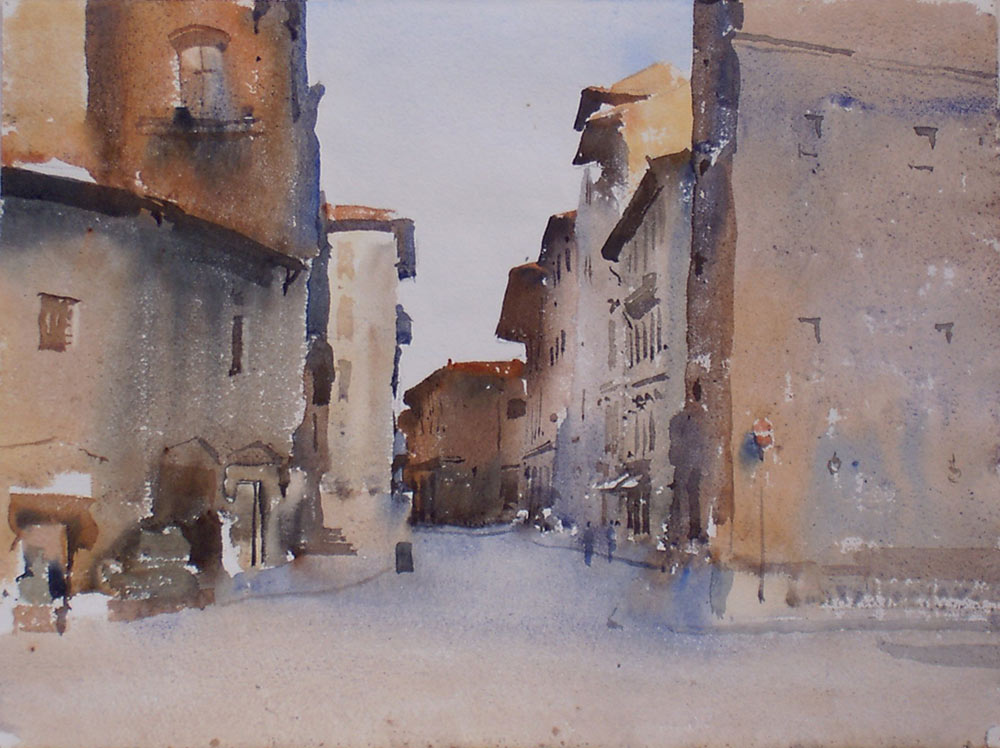
The Palace of the Bargello
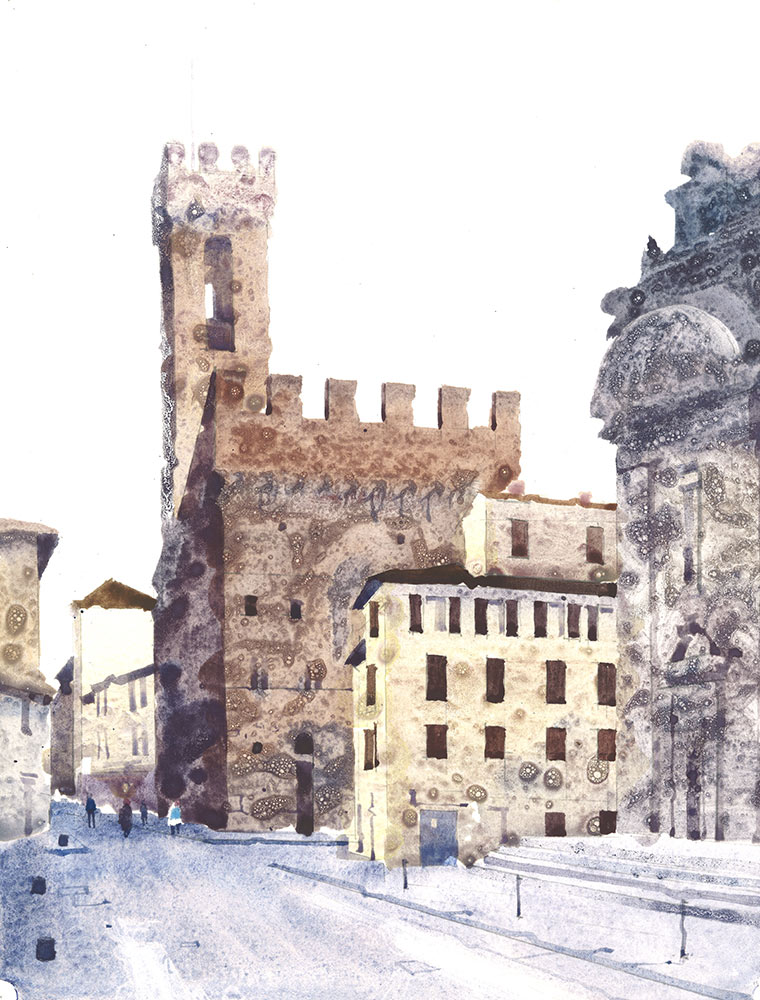
The baroque building to the right of my painting, originally a convent, was built in the 17th and 18th centuries and is now court rooms. Towards the left is the gothic fortress palace of the Bargello, begun in 1255 and clearly created in a more defensive time, incorporating an older tower. The name Bargello originates from its use in the 16th century as the seat of the bargello or captain of justice and for a long period it was used as a prison.


